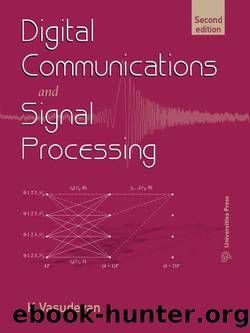Digital Communications and Signal Processing by K Vasudevan

Author:K Vasudevan [Vasudevan, K]
Language: eng
Format: azw3
Tags: Digital Communications and Signal Processing
Publisher: Universities Press (India) Private Limited
Published: 2017-01-17T16:00:00+00:00
Figure 4.9 The baseband equivalent model of a CDMA transmitter
Figure 4.10 Receiver for users 1 and 2
where the autocorrelation of ṽ(t) is given by (4.53). The output of the matched filter for user 1 is
x̃1(t) = ∑ k=-∞∞S 1,kh11(t - kT) + ∑ k=-∞∞S 2,kh21(t - kT) + Z̃1(t) (4.83)
where h11(t) and h21(t) are shown in Figure 4.10 and
Z̃1(t) = ṽ(t) ⋆ pl(-t). (4.84)
The output of the sampler is
x̃1(iT) = S1,ih11(0) + Z̃1(iT)
= S1,iA2T+Z̃1(iT)
= S1,i + z̃1(iT) (4.85)
where we have set A2T = 1 for convenience. Note that the autocorrelation of Z̃1(iT) is given by (4.68). Using the union bound, the probability of symbol error for user 1 is
P(e) = erfc d2 8N0. (4.86)
The probability of symbol error for the second user is the same as above.
Solution 2: Consider the alternate model for the CDMA transmitter as shown in Figure 4.11.
Note that here the transmit filter is the same for both users. However, each user is alloted a spreading code as shown in Figure 4.11. The output of the transmit filter of user 1 is given by
S̃1(t) = ∑ k=-∞∞∑ n=0Nc-1S 1,c,k,np(t - kT - nTc) (4.87)
where Nc = T∕Tc (in this example Nc = 2) denotes the spread factor and
S1,c,k,n = S1,kc1,n -∞ < k < ∞,0 ≤ n ≤ Nc - 1. (4.88)
The term S1,k denotes the symbol from user 1 at time kT and c1,n denotes the chip at time kT + nTc alloted to user 1. Note that the spreading code is periodic with a period T, as illustrated in Figure 4.12(c). Moreover, the spreading codes alloted to different users are orthogonal, that is,
∑ n=0Nc-1c i,ncj,n = NcδK(i - j). (4.89)
This process of spreading the symbols using a periodic spreading code is referred to as direct sequence CDMA (DS-CDMA).
Let us now turn our attention to the receiver. The baseband equivalent of the received signal is given by
ũ(t) = ∑ k=-∞∞∑ n=0Nc-1S 1,c,k,np(t - kT - nTc)
+ ∑ k=-∞∞∑ n=0Nc-1S 2,c,k,np(t - kT - nTc) + ṽ(t) (4.90)
Download
This site does not store any files on its server. We only index and link to content provided by other sites. Please contact the content providers to delete copyright contents if any and email us, we'll remove relevant links or contents immediately.
Grails in Action by Glen Smith Peter Ledbrook(9163)
Sass and Compass in Action by Wynn Netherland Nathan Weizenbaum Chris Eppstein Brandon Mathis(8808)
Azure Containers Explained by Wesley Haakman & Richard Hooper(7440)
Configuring Windows Server Hybrid Advanced Services Exam Ref AZ-801 by Chris Gill(7432)
Kotlin in Action by Dmitry Jemerov(7263)
Running Windows Containers on AWS by Marcio Morales(6981)
Microsoft 365 Identity and Services Exam Guide MS-100 by Aaron Guilmette(5399)
Microsoft Cybersecurity Architect Exam Ref SC-100 by Dwayne Natwick(5208)
Combating Crime on the Dark Web by Nearchos Nearchou(4978)
The Ruby Workshop by Akshat Paul Peter Philips Dániel Szabó and Cheyne Wallace(4667)
Management Strategies for the Cloud Revolution: How Cloud Computing Is Transforming Business and Why You Can't Afford to Be Left Behind by Charles Babcock(4527)
Python for Security and Networking - Third Edition by José Manuel Ortega(4233)
The Age of Surveillance Capitalism by Shoshana Zuboff(4209)
Learn Wireshark by Lisa Bock(4115)
The Ultimate Docker Container Book by Schenker Gabriel N.;(3886)
Learn Windows PowerShell in a Month of Lunches by Don Jones(3681)
DevSecOps in Practice with VMware Tanzu by Parth Pandit & Robert Hardt(3566)
Windows Ransomware Detection and Protection by Marius Sandbu(3540)
Blockchain Basics by Daniel Drescher(3507)
